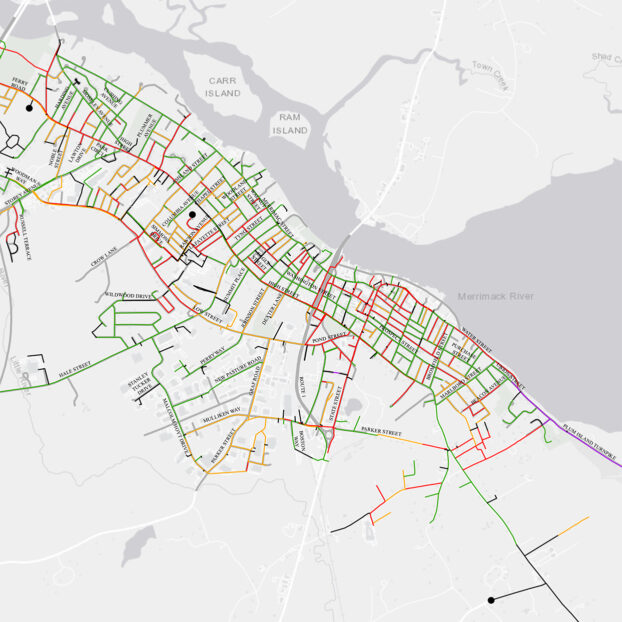EP was retained by the City of Newburyport in 2021 to provide a rate study for the City’s Water System and Sewer System. Generally the City’s rates had not been comprehensively evaluated since the early 2000s. The purpose of the Water System rate study was to evaluate the City’s rates and fees in comparison to peer utilities, industry benchmarks, debt service, and current 5-year capital plan. The project was expanded to include development of a 15-year water distribution system capital improvement plan to update the City’s previous long-term plan that had been developed in 2002.
The updated plan focused primarily on the City’s distribution system assets (i.e. pipes, pump stations, storage tanks), but incorporated water supply and treatment projects currently identified in their 5-year plan. Capital improvement recommendations were summarized in a technical report to provide the City with a comprehensive plan including planning level project costs for phased implementation over the next 15 years.
The existing water supply system serves 100% of the City of Newburyport (approximately 18,200 people) as well as parts of the towns of Newbury and West Newbury through 104 miles of water main, four reservoirs, two groundwater wells, three pump stations, two booster stations, two storage tanks, and one water treatment plant.
Rate Study
The water system rate study evaluated the City’s rate and fee structure to meet their operating and capital budget over the FY22 through FY26 time period. The rate study compared the City’s existing rate and fee structure against several peer utilities as well as industry benchmarks for debt service, retained earnings, and nonrevenue water. Based upon the City’s existing operating budget and 5-year CIP, Environmental Partners developed four alternative rate scenarios that varied the amount of capital funding and retained earnings provided by rate revenue. The results of the rate analysis were prepared in a technical memorandum and presented to City staff and the Board of Water and Sewer Commissioners. The City utilized some of the recommendations in developing their FY23 rates. The rate study findings included a recommendation to prepare a longer term capital improvement plan to support annual rate evaluations moving forward.
Water System Assessment
As part of the water system capital improvement plan an assessment of the City’s water distribution system was conducted. The assessment consisted of an evaluation of the existing water system infrastructure, including distribution piping, water storage tanks, and pumping stations that make up the distribution system. The water supply and treatment assets were incorporated, but are being evaluated more thoroughly under other projects currently in progress. EP documented capacity, engineering design and operation statistics, age, status, and general condition of the water system infrastructure.
In evaluating the water distribution system, EP prepared an updated inventory of the City’s distribution system assets based upon work completed since the 2002 master plan. The distribution system piping was assessed and ranked based on age, material, hydraulic deficiencies, and history of leaks and breaks. The evaluation also incorporated the City’s pavement management program to identify water mains that were located within streets scheduled for full reclamation or mill and overlay within the 15-year planning period. The assessment criterion were weighted to develop a numeric value for each pipe segment to develop a prioritized list of water main improvements.
Recommended Distribution Improvements
In order to give structure to the recommended water system improvements and to aid the City in financing the proposed program, EP organized its recommendations into three phases each covering a 5-year period (Phase 1: 2023-2027, Phase 2: 2028-2032, and Phase 3: 2033-2037). Planning level construction cost estimates (construction, engineering, and contingency) were developed for projects not currently in the City’s 5-year CIP. Phase I improvements focused on the highest scored water mains along with several previously identified capital projects (e.g. water meter replacement program and replacement of a key transmission main). The assessment recommended the City establish a goal of replacing approximately 0.5% of their water distribution mains annually moving forward. These Phase I water distributions improvements addressed immediate water distribution system problems, such as deficiencies in water pressure or fire flow availability, mains with a long history of leaks/breaks, and should be implemented as soon as possible. Phase 2 Improvements target focused on water supply, treatment plant, and pump station improvements to address water quality, hydraulics, and resiliency. Phase 3 improvements, while not immediately critical, are intended to reinforce the water system and improve its overall performance, aging infrastructure, and reliability.
Within the CIP, EP developed capital costs for each phase of the recommended improvements including all costs for the study, design, and construction, including contingencies and engineering assistance for bidding, construction administration, and resident engineering services for construction projects. The overall 15-year CIP identified approximately $60.3 Million in system recommendations over the next 15 years.
CIP Implementation
EP is now working with the City on planning for implementation of the CIP and evaluating expanding their water system planning through development of an asset management plan including a hydraulic model and unidirectional flushing program.





